Wolverhampton Corporation Tramways
History
Wolverhampton Council was entitled, under the provisions of the Tramways Act of 1870, to acquire the lines of the two tramways within the town, but only after a certain period of time had elapsed — usually twenty-one years from the authorisation of the tramway and every seven years thereafter — and provided that notice was served on the owning company within a certain timeframe. Both the tramways that operated within the town were standard gauge, one a horse tramway opened in 1878 (owned by the Wolverhampton Tramways Company), and the other a steam tramway opened in 1883 (owned by the Dudley and Wolverhampton Tramways Company). The opportunity to compulsorily purchase both of these tramways, or rather, the portions of them that lay within the municipal boundary, would fall due towards the end of the 1890s, so in late 1896, the council formed a Tramways Committee to assess the various options open to it, and to make a recommendation.
Around the same time, the British Electric Traction Company, which was developing ambitious plans for a large 3ft 6ins-gauge electric tramway system centred on the Black Country and Birmingham, began negotiations with the various local authorities (including Wolverhampton) and tramway companies, in order to gain their support and also, deferment of the dates on which the authorities' had the right to buy the tramways within their respective municipal boundaries. In 1897, the BETCo promoted its Wolverhampton and District Tramways bill, which would have given it powers to acquire and convert the tramways of the D&WTCo, the WTCo, and the South Staffordshire Tramways Company. Unfortunately, it could not overcome the numerous objections and demands of Wolverhampton Corporation, so it had to withdraw the bill. The BETCo made two further attempts to appease the corporation (in May 1897 and January 1898), finally reaching agreement on all bar one point — the high price demanded by the corporation for municipally generated electricity — which proved to be a step too far for the company.
Despite these setbacks, the BETCo pushed ahead with its plans, reaching agreement with other local authorities, as well as with the existing horse and steam tramway companies in the area, all of which it had gained control of by 1898. It acquired the tracks and assets of the Dudley and Wolverhampton Tramways Company on the 22nd April 1899, together with pending powers to convert the line to 3ft 6ins-gauge and electric traction, the latter being granted on the 9th August 1899 (under the Dudley and Wolverhampton Tramways Order, 1899). Likewise, it acquired the tracks and assets of the Wolverhampton Tramways Company (outside the Wolverhampton municipal boundary) on the 1st May 1900, together with existing powers to convert them to 3ft 6ins-gauge and electric traction (under the Wolverhampton Tramways Order, 1899).
Following its failure to reach agreement with the BETCo, which had hoped to operate a tramway system within the borough, either built by the company or leased from the corporation, the council decided — in July 1898 — to purchase that tramway lines within the borough, and to seek powers to build and operate a municipal electric tramway system. The powers, which were granted on the 9th August 1899 — under the Wolverhampton Corporation Act, 1899 — included all the WTCo's Tettenhall line, as well as substantial portions of the Willenhall and Bilston lines, to the municipal boundary at Deans Road (Heath Town Urban District Council) and Stow Heath Lane (Bilston Urban District Council), respectively. Whilst awaiting its powers, the corporation served notice on the WTCo — on the 6th October 1898 — of its intention to purchase the lines within its boundary.
Despite much negotiation, the corporation and the WTCo (and hence the BETCo) could not agree on the price to be paid for the lines and assets of the WTCo within the municipal boundary. After resorting to arbitration, a price was set and the tramway was finally handed over to the corporation (and the remainder to the BETCo, including powers to convert the lines to electric traction) on the 1st May 1900. Whilst the corporation and the BETCo endeavoured to keep the horse tram services running from each end of the two lines that had been divided (Willenhall and Bilston), there now arose the thorny issue of the municipal boundary, which actually ran down the centre of the road on each route for around half a mile. This meant that on each line, and for several hundred yards, one rail of the horse tramway track was within Wolverhampton, whilst its partner was in that of the neighbouring Urban District Councils. Various sensible solutions were proposed, primarily by Bilston UDC, but the corporation dug its heels in, refusing point blank to allow the BETCo to operate any service within the borough. This resulted in the farcical situation of passengers having to walk around half a mile on each line, from one operator's horse trams to the other's. This situation did not, however, last long, as the BETCo quickly substituted horse buses on the Willenhall line (on the 2nd June 1900), with the Bilston line following in September.
By this time, the BETCo had also obtained powers to convert the steam tramway to 3ft 6ins-gauge and overhead electric traction, which had been granted to the company on the same day as the corporation's electric powers (9th August 1899), under the Dudley and Wolverhampton Tramways Order, 1899. The corporation had, however, succeeded in inserting various clauses into the order, one of which gave it the right to buy the tracks within the borough (Snow Hill to Fighting Cocks) within two months of the order's approval, the corporation duly serving notice on the company on the 20th September 1899, though the right-to-buy was not until August 1901.
The following year, the BETCo obtained further powers to build 3ft 6ins-gauge electric tramway lines centred on Bilston, approved under the South Staffordshire Light Railway Order, 1900 (on the 11th August), and the South Staffordshire Light Railway (Extensions) Order, 1900 (on the 1st September 1900). Following this (on the 17th December 1900), it set up a new subsidiary — Wolverhampton District Electric Tramways Limited — to take over the lines that it had acquired from the WTCo and the D&WTCo, as well as those that it intended to build under the South Stafford Staffordshire Light Railway Orders.
The company made several further attempts to persuade the corporation to either allow it to lease the corporation's system once it had been constructed, or to agree to through running into Wolverhampton. However, the corporation would under no circumstances entertain a company operating in the town, nor would it countenance the erection of the overhead wiring to enable it. By January 1901, the company could wait no longer, so pressed on with the conversion of the steam tramway, excepting the portion within the municipal boundary, the last steam services running on the 21st February 1901. After some legal shenanigans on the part of the BETCo, the corporation is thought to have finally purchased the section within its boundary in August 1901.
Another obstacle to through running was the corporation's decision (in May 1901) to use an unproven surface-contact current-collection system manufactured by the Lorain Steel Company of Ohio, USA. Although the Tramways Committee had twice recommended installation of the considerably cheaper, and well-understood overhead system of current collection, and had even issued tenders for the equipment (in August 1900), there was clearly a powerful faction within the council opposed to it, presumably on aesthetic grounds. This faction succeeded in persuading the council to revisit its decision, and to assess two surface-contact systems (Dolter and Lorain); the outcome, despite divisions within the council, was a decision (in May 1901) to accept the proposal of the Lorain Company to install a trial section, which if proven successful over a 30-day period, would then be used for the entire municipal system. Moreover, the company also agreed to remove all the equipment after twelve months should it not prove to be to the council's satisfaction.
Construction commenced on the 20th May 1901, the corporation horse trams on the Bilston Road route running for the last time on the 17th September 1901, and the trial section of Lorain-equipped line opening on the 6th February 1902. The trial line was operated successfully for the stipulated 30-day period, following which further lines were equipped and opened between 30th April and the 13th September 1902. In order to circumvent the boundary problem on the Bilston line, which ran along the centre of the road for around half-a-mile — between Ettingshall Lane and Stow Heath Lane — the corporation built its new Lorain tracks (opened on the 24th September 1902) on its side of the boundary, the tracks meeting those of the WDET at Stow Heath Lane. The relationship between the two parties seems, however, to have thawed somewhat by the 24th January 1903, when the company agreed that the corporation's horsecars on the Willenhall line could run through to Dean's Road, the boundary here once again running along the centre of the road — between Coventry Street and Dean's Road — each party owning one rail.
Further powers were obtained under the Wolverhampton Corporation Tramways Acts of 1902 and 1904, a second tranche of electric lines opening between the 8th March and the 13th August 1904. The last horsecar service — on the Willenhall line — was withdrawn on the 24th January 1904, the corporation having operated horse trams for a few months short of four years.
Meanwhile, on the 4th December 1903, it was agreed that all the BETCo's Black Country and Birmingham-area tramway interests would be merged into Birmingham & Midland Tramways Limited. From the 1st July 1904, all these systems (operated by Birmingham and Midland Tramways Limited; the City of Birmingham Tramways Company; the Dudley, Stourbridge and District Electric Traction Company; the South Staffordshire Tramways [Lessee] Company; and Wolverhampton District Electric Tramways Limited) were managed as a single entity by the Birmingham and Midland Tramways Joint Committee (B&MTJC). The merger resulted in economies of scale across the enterprise, perhaps most notably in the introduction of a very successful Tramways Parcels Express Service (begun in 1905), and the setting up of a major tramcar building and maintenance facility at Tividale, between Dudley and Oldbury.
Whilst the tracks of the corporation and the WDET now met at three points on the municipal boundary (Fighting Cocks, Dean's Road, and Stow Heath Lane), and were connected at the latter two places, no through running took place, members of the public having to change from one operator's electric tramcars to the other's. The lack of through-running was a constant source of public criticism, so it was not long before the BETCo once again approached the corporation (in February 1905) to see whether they might come to some arrangement. Although the corporation was still implacably opposed to the installation of overhead wiring in the town, its position on company operation over its tracks had noticeably softened. As a result, agreement was reached for the corporation to equip some of its cars with overhead current collection equipment, and for the WDET to equip some of its cars with Lorain surface-contact equipment. The agreement resulted in the corporation taking over all services to Bilston and Willenhall (from the 9th November 1905, and the 18th April 1906, respectively), with WDET cars running right through from Dudley to Wolverhampton (from the 15th October 1906). The latter services, however, only lasted until the 10th January 1909, as there was little increase in revenue on the line — in large part due to a severe trade depression — and the Lorain-equipped cars, which were over a ton heavier, proved to be expensive to operate and maintain.
The last addition to the corporation system, which opened on the 10th September 1909, was out to Penn Fields. This took the system to its final size of 13.85 miles, lines running northwestwards to Tettenhall and Whitmore Reans; northwards to Bushbury; northeastwards to Wednesfield; eastwards to Willenhall (as far as Dean's Road); southeastwards to Bilston (as far as Stow Heath Lane); southwards to Fighting Cocks; and southwestwards to Penn Fields.
The initial batch of 24 tramcars were joined by a further 19 between early 1904 and late 1906, a further six in 1908/9, and three in 1913.
Like many systems during the Great War, the system suffered from greatly increased loading and reduced maintenance, the latter resulting from severe restrictions on spares and materials, coupled with the loss of skilled workers to the armed forces. The tramway emerged from the conflict in badly run-down condition, especially the Lorain system, which was effectively life expired, and in need of complete replacement. Despite rampant post-war inflation and severe difficulties with supply, the corporation did managed to obtain seven new Lorain-equipped tramcars, which were delivered in 1920. However, in the time between the order and their delivery, the decision had been taken — on the recommendation of the General Manager — to convert the entire system to overhead current collection. The conversion was far from cheap, so involved the corporation in significant expense (and presumably borrowing), the first newly converted line opening on the 26th March 1921 and the last on the 15th October. A further eleven new tramcars arrived in 1921 and 1922.
As a consequence of the conversion, services on the Bilston and Willenhall lines were able to run right through to their termini without stopping to change current-collection method (from the 15th June 1921, and the 22nd June 1921, respectively), whilst the WDET was able to reintroduce through services on the Dudley line, these running right through to Wolverhampton Snow Hill from the 26th March 1921.
The corporation had operated motorbuses as early as the 1st September 1905, but had struggled with the unreliability of the vehicles, abandoning their operation on the 20th July 1909. The corporation tried again on the 7th September 1911, this time more successfully, and though this led to a modest expansion of bus services during the remainder of the decade, it wasn't until the 1920s that their numbers increased significantly. The name of the operating department was changed to Wolverhampton Corporation Tramways and Motors around 1921, presumably to better reflect the changing transport offering, and again in February 1926, to Wolverhampton Corporation Transport.
Whilst the corporation was busy with the conversion of its tramway system, the BETCo, in the form of the Birmingham District Power and Traction Company Limited (the immediate parent company of the WDET), attempted to deal with the looming threat of local authority lease expirations across its Black Country tramway systems. Although it submitted a parliamentary bill, and entered into lengthy dialogue with the local authorities in an attempt to push the various expirations out to a single date of the 31st December 1938 (in return for significant investment), several of the larger authorities, particularly West Bromwich and Wolverhampton, which were committed to expansion of municipal operation, would not agree to any extension of the company's leases. As a consequence, the resulting bill — the Black Country Tramways and Light Railways Act, 1922 — was almost worthless as far as the company was concerned, and effectively signalled the end of the company-operated network.
Although the WDET did not own any lines within Wolverhampton, the corporation had, since its act of 1899, had the power to compulsorily purchase tramway lines outside the municipal boundary when the leases of the neighbouring authorities expired, providing that these lines were extensions of its own lines. The corporation had been successful in protecting these rights — within BDP&TCo's Black Country Tramways and Light Railways Act, 1922 — as well as harmonising dates at which the neighbouring authorities could purchase the tramways within their boundaries, moves which were aimed at expanding the municipal tramway system. However, on the 16th January 1923, members of the council travelled to Birmingham to see that corporation's new trolleybuses, a visit which was to lead to a major change in transport policy. Despite having converted the tramway system to overhead current collection barely two years before, the council endorsed a recommendation from the General Manager to replace the worn-out Wednesfield tramway line with trolleybuses, the last tram duly running on the 23rd July 1923, and the first trolleybus on the 29th October 1923. This was followed by the Bushbury line, the last tramcar services over it ceasing on the 19th August 1924, following which motorbuses were deployed until the conversion to trolleybus operation was completed, a pattern that was to be repeated several times over the next five years.
The above conversions were carried out with the blessing of the Minister of Transport, but without formal powers to do so. This situation was rectified by the passing of the Wolverhampton Corporation Acts of 1925 (on the 7th August) and 1928 (on the 3rd August), which gave the corporation powers to convert its own tramway lines to trolleybus operation, as well as lines that were either owned by the WDET or leased to it. This involved the corporation in long but successful negotiations with the WDET, as well as with several of the neighbouring local authorities. As a result, the corporation's own tramway system was gradually closed, and converted to trolleybus operation, with motorbuses taking over services in the interim, the last tram of all running over the Bilston line on the 26th August 1928.
The corporation's tramway abandonment was, however, only to last for five days, as on the 1st September 1928, it took over operation of the WDET's remaining Bilston-area services (and the tramcars necessary to work them), namely: Fighting Cocks to Bilston, Willenhall to Darlaston (via Bilston), and Bilston to Bradley. These services were soon withdrawn, the last corporation tram running on the 30th November 1928.
Uniforms
Following the take-over of the Wolverhampton Tramways Company on 1st May 1900, the corporation lost no time in branding its newly acquired enterprise by issuing smart uniforms to both horsecar conductors and drivers; staff had previously worn smart but informal attire (see link). The uniforms were in blue serge with orange piping, and initially comprised single-breasted jackets with four or five buttons (probably in brass and bearing a municipal device — see link) and lapels, worn together with white shirts and kepi-style caps. It is unclear whether the caps or jackets bore any insignia.
These uniforms appear to have been an interim measure, as all photographs taken during the early years of the electric era show tramcar staff wearing single-breasted tunics with five buttons and stand-up collars; the latter bore 'W C T' in individual metal letters on the right-hand side (very likely in brass), and probably on the left side too, though confirmatory photographic evidence is currently lacking. The drooping-peak caps carried script-lettering badges — either 'Motorman' or 'Conductor' — above which a small municipal-device badge was worn (see below for an example); the insignia were almost certainly brass.
These early electric-era uniforms do not appear to have lasted for more than two or three years, a change certainly having been made by 1908, and possibly as early as 1905/6. Conductors were now issued with single-breasted jackets with five buttons, two breast pockets (with button closures), stand-up collars and epaulettes; the collars carried system initials — 'W C T' — on both sides, whilst the epaulettes had a button fastening and bore the same municipal-device badge that was used on the caps. Motormen on the other hand were issued with double-breasted, lancer-style tunics with five pairs of buttons (narrowing from top to bottom), stand-up collars and epaulettes; both the collars and the epaulettes carried the same insignia as used on the conductors' jackets. The caps were also changed, to a peaked style with a tensioned crown (top); they continued to carry a grade badge and a small municipal-device badge.
At some point, the use of script-lettering grade badges on the caps appears to have been phased out, leaving just the municipal-device badge as the sole cap adornment. Towards the end of tram operation (1928), it is possible that tramcar crews were issued with a more modern style of uniform, which was certainly worn by motorbus and trolleybus men during the last few years of the tramway. The new style of jacket was double-breasted with four pairs of buttons, lapels and button-closed epaulettes; the latter bore the standard municipal-device badge, whilst the collars bore 'W.C.T.' in embroidered script lettering. Tensioned-crown peaked caps with woven straw crowns were also used, though these were possibly for summer use only.
Tramcar crews were also provided with double-breasted greatcoats with five pairs of buttons and high, fold-over collars; the latter appear to have carried some kind of embroidered insignia, possibly 'W C T'. These garments initially had no epaulettes, but like the jackets worn underneath, subsequently had them.
Tramcar staff were also required to wear round licences when on duty; these appear to have been used between the mid-Edwardian era and the Great War only.
Although photographs of senior staff taken during the horse-tram era have not survived, documentary evidence indicates that they wore blue serge uniforms embellished with gold, the latter presumably embroidered.
During the electric era, inspectors were issued with single-breasted jackets edged in a finer material than the main body of the jacket, with hidden buttons (or more likely a hook a eye affair) and stand-up collars; the latter appear to have carried embroidered 'W C T' initials on both sides. Caps were probably of the drooping-peak type initially, but were soon changed to a tensioned-crown, peaked style (by 1908 at the latest); the caps carried the standard municipal-device badge, with the grade — 'Inspector' — beneath it in embroidered script-lettering (on a hat band).
In common with many tramway systems, women were employed in considerable numbers during the Great War to replace male staff lost to the armed services. Female staff were issued with tailored, double-breasted jackets with three pairs of buttons and lapels, together with matching skirts; no insignia of any kind appears to have adorned the uniforms. Headgear came in two forms, a peaked cap with a wide crown (presumably for winter wear), and the other a dark-coloured straw bonnet (presumably for summer wear). Both types of hat carried the usual municipal-device badge and a grade badge, thought not always together. A photograph below indicates that the ladies were also issued with long, tailored, single-breasted coats fastened with a belt (adorned with a button).
Further reading
For more information on the tramways of Wolverhampton, see 'A History of Wolverhampton Transport, Volume I, 1833-1930; S Webb and P Addenbrooke (Birmingham Transport Historical Group).
Images
Horse tram drivers and conductors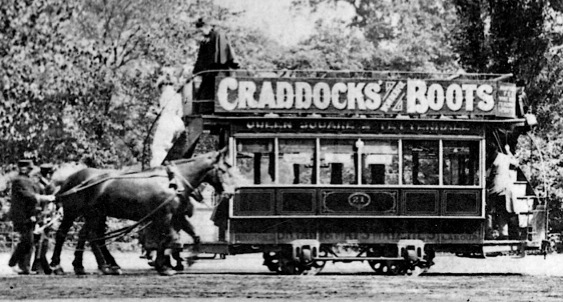
Two corporation horsecar staff turn Car No 21's horses at the Newbridge Terminus — photo undated, but certainly taken between the corporation take-over (1st May 1900) and the last horsecar service over this terminal section (January 1902), as both men are wearing corporation uniforms. Photo courtesy of the Tramways and Light Railway Society, with thanks to David Voice.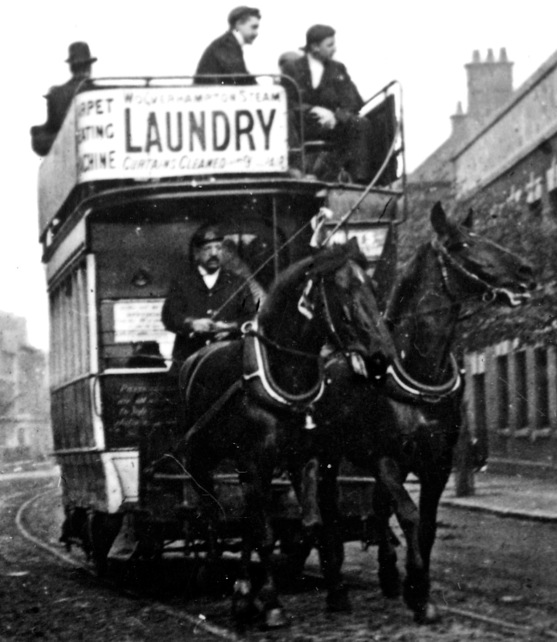
A corporation horsecar driver in Chapel Ash, seemingly so intent on his charges that he hasn't noticed the photographer — photo undated, but again clearly after May 1900 as he sports a uniform and kepi-style cap. Although his cap appears to carry a large cap badge, this is possibly just a trick of the light. Photo courtesy of the Tramways and Light Railway Society, with thanks to David Voice.
Motormen and conductors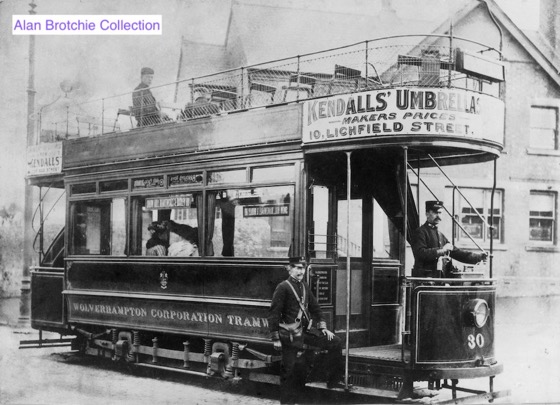
A conductor and a motorman pose on the platform of Tramcar No 30 at Fighting Cocks — photo undated, but given the condition of the tram, probably taken in 1904 or 1905.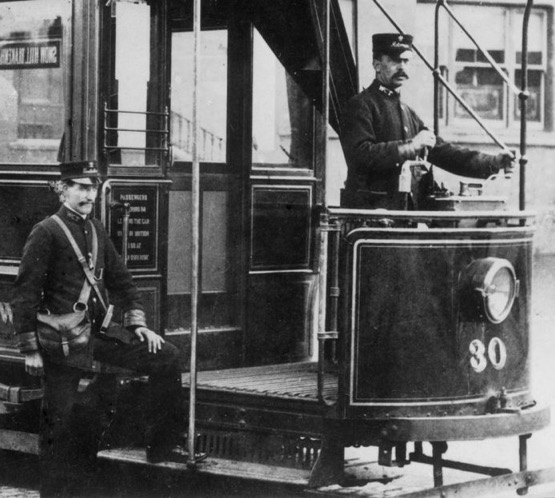
An enlargement of the above photograph showing the crew; the 'W C T' collar badges are easily made out, as is the general shape of the small municipal-device cap badge.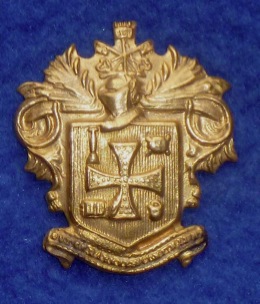
Wolverhampton Corporation municipal-device cap badge (and later epaulette badge), worn by tramways staff throughout the life of the tramway — brass. Author's Collection.
General pattern script-lettering grade cap badges (brass), as worn by Wolverhampton Corporation Tramways tramcar crews. Author's Collection.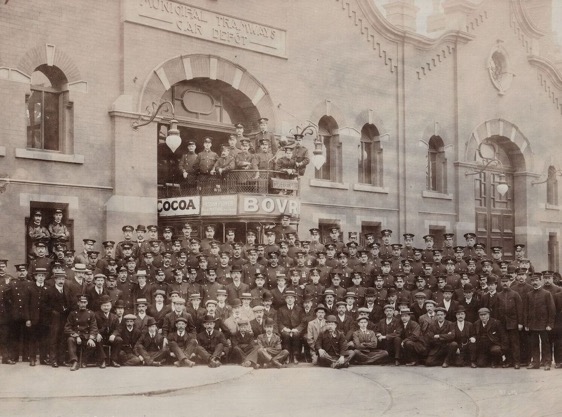
A staff photograph taken at Cleveland Road around 1908. All those present are wearing tensioned-crown peaked caps, which had clearly superseded the drooping-peak caps by this date.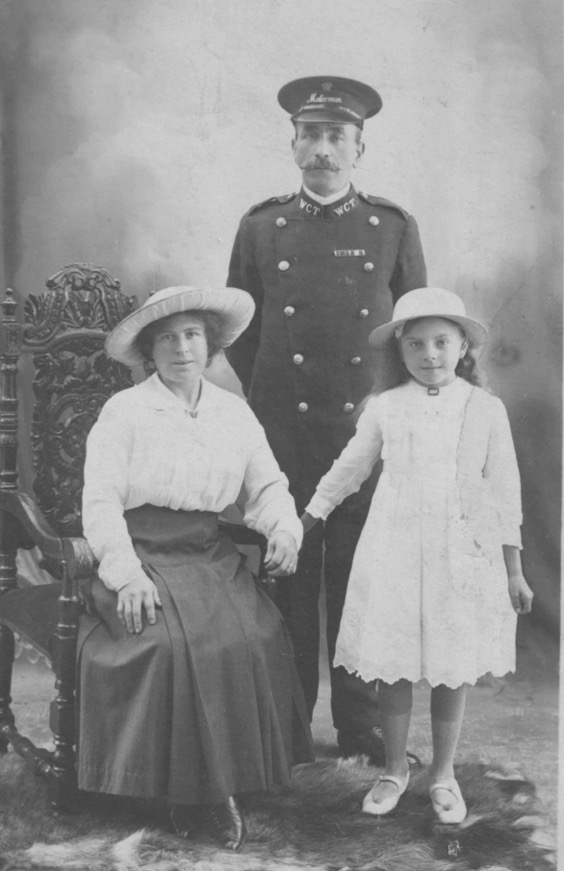
A studio portrait of an unidentified WCT motorman with his wife (named Florie) and daughter (who died shortly after the photo was taken according to the rear of the card) — photo undated, but given that the medal ribbon includes both the Queen's and the King's South Africa Boer War medals, it was probably taken in the mid-to-late Edwardian era. Author's Collection.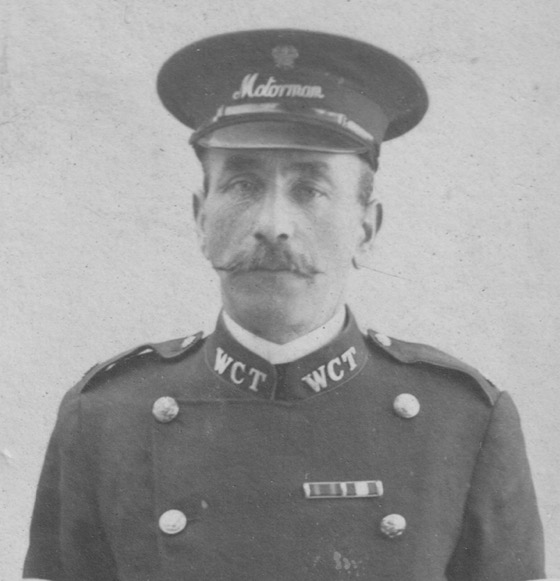
An enlargement of the above photograph showing details of the motorman's tunic and cap. The collars bear individual 'W C T' initials, whilst the cap and epaulettes bear the standard municipal-device badge.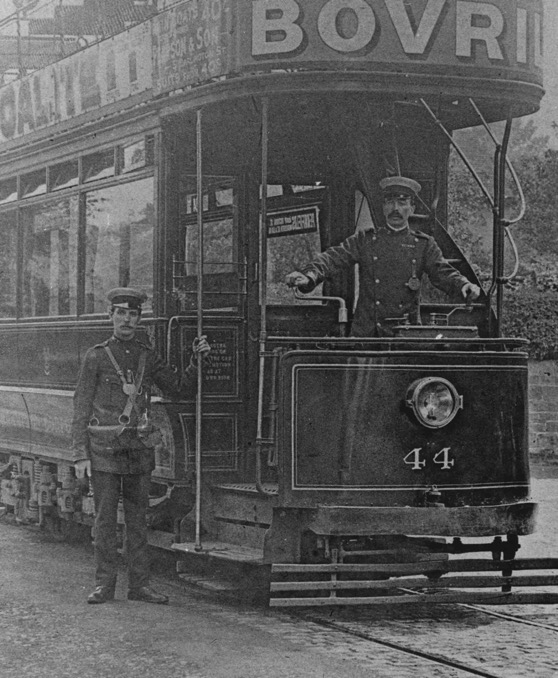
The crew of Tramcar No 44 pose for the photographer at the terminus at Penn Fields — photo undated, but given the excellent condition of the tram, probably taken in 1909, the year after it was delivered. Both are wearing municipal licences, which are not evident in other photos. Author's Collection.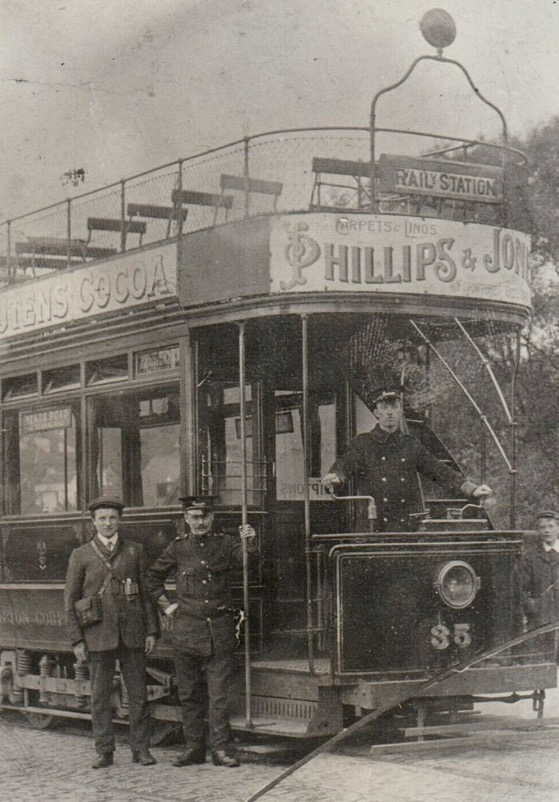
The crew of Tramcar No 35 with a trainee conductor at what is possibly Wergs Rd — photo undated, but probably late Edwardian. 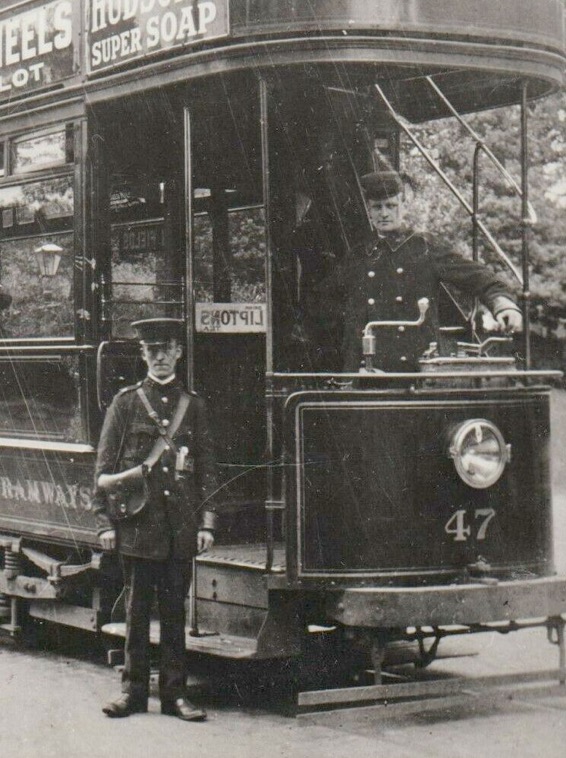
A conductor and a motorman pose with Tramcar No 47 at Penn Fields — photo undated, but possibly taken shortly after the Great War as the vehicle is top covered. 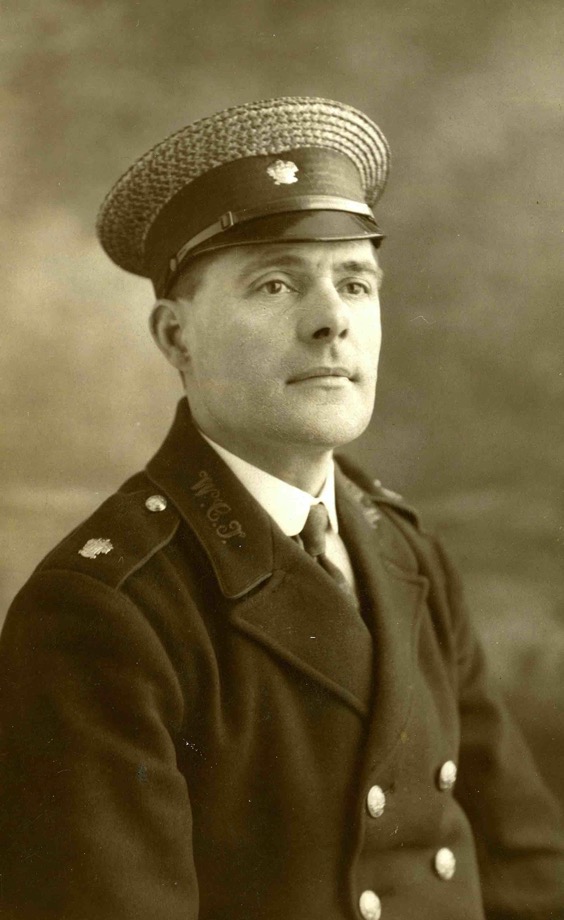
A studio portrait of Wolverhampton Corporation Transport employee Frank Turley. Frank was born in 1880 and died in 1950, and looks to be in his late 40s in the photograph, which would date it to the late 1920's or early 1930's. He is believed to have been a bus driver rather than a tram motorman, though the uniform was almost certainly issued to all the corporation's drivers in the mid-to-late 1920s, irrespective of the type of vehicle they drove. Photograph courtesy of Ralph Hickman.
Senior staff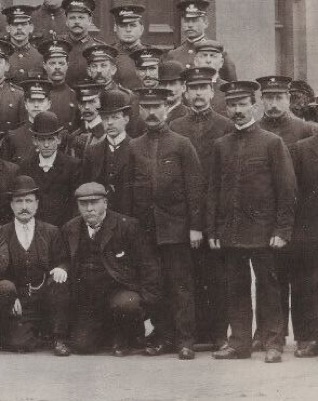
An enlargement of the c1908 Cleveland Road staff photo above showing four of the inspectors. They are wearing typical tramway inspector uniforms with the grade embroidered on their caps, and with what would appear to be system initials on their collars.
Female staff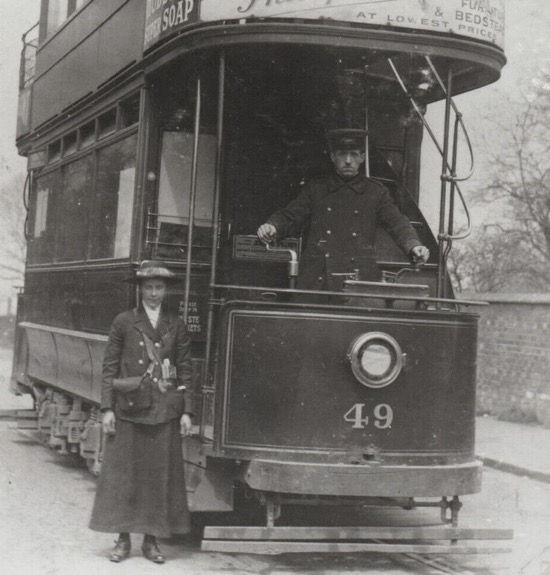
A conductress and her rather sullen-looking colleague with Tramcar No 49 at the Penn Fields terminus — photo undated, but very probably taken early in the Great War. She is wearing a double-breasted jacket, matching skirt and dark-coloured, wide-brimmed bonnet, all seemingly devoid of insignia. She is, however, wearing a licence, which can just be made out underneath her ticket clipper. 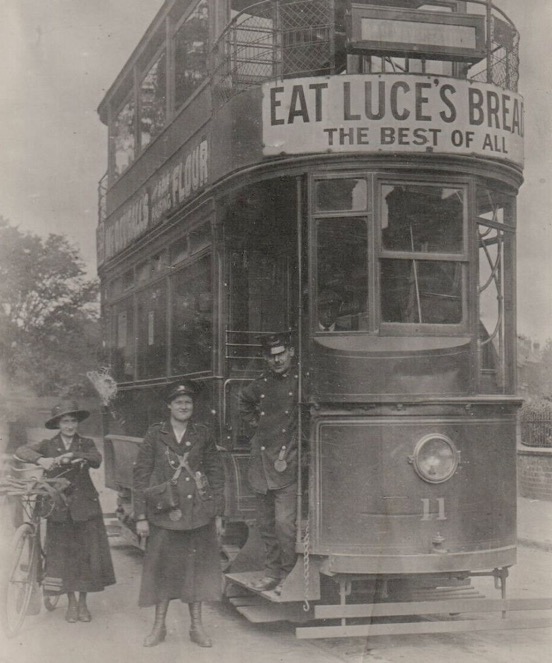
A Great War conductress (centre) and a motorman, with Tramcar No 11 at what is believed to be Bushbury Lane. Her caps bears the standard municipal-device badge, and possibly a grade badge too; the jacket is completely without insignia, though once again, the subject is clearly wearing a municipal licence.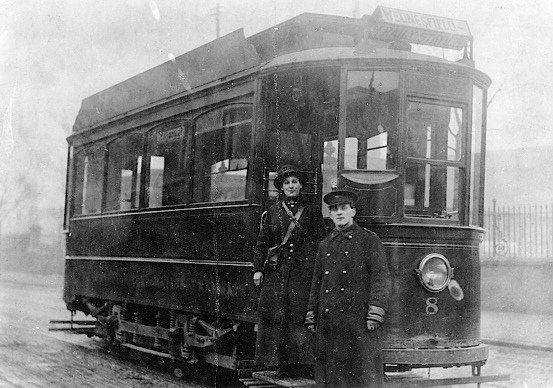
A Great War conductress and a motorman pose with Tramcar No 8 outside the corporation depot in Cleveland Rd. Photo courtesy of the Tramways and Light Railway Society, with thanks to David Voice.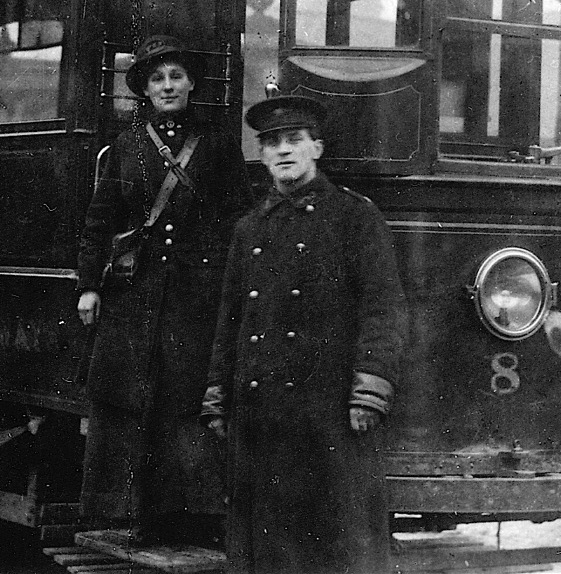
An enlargement of the above photograph showing the conductress and the motorman. The conductress's cap badge is a bit of a mystery as other photos clearly show female staff wearing the standard municipal-device badge or a script-lettering cap badge. The motorman is wearing the small municipal-device cap badge, with no sign of a script-lettering grade badge.